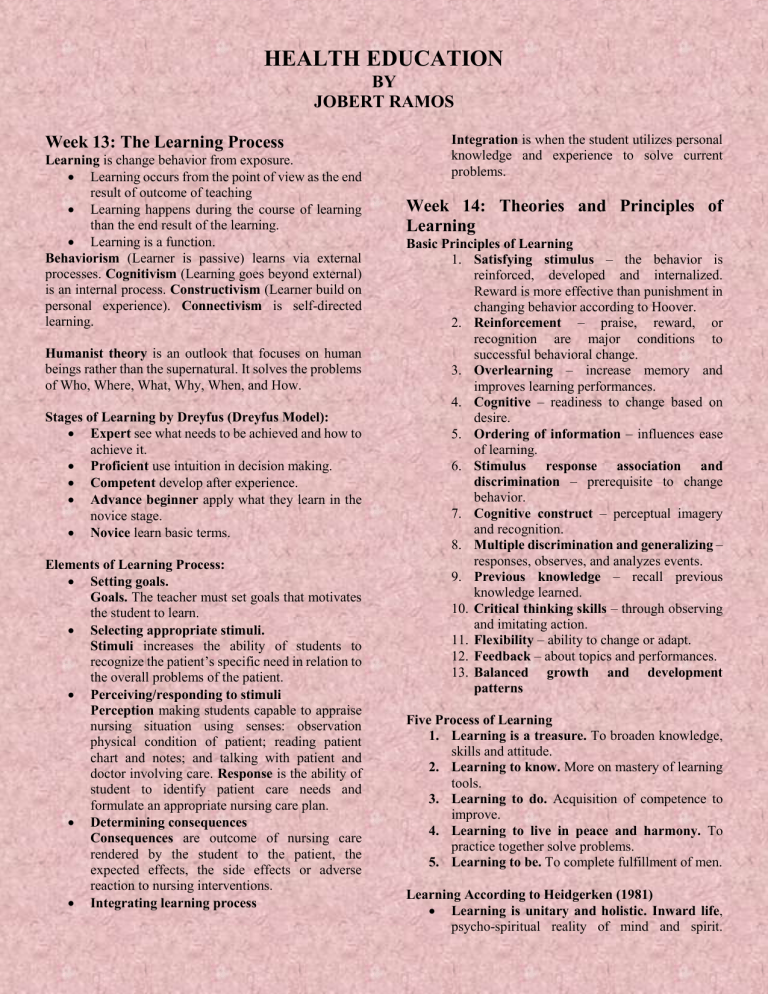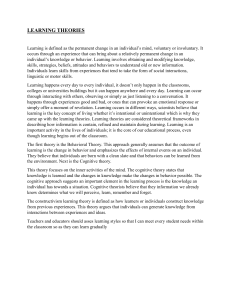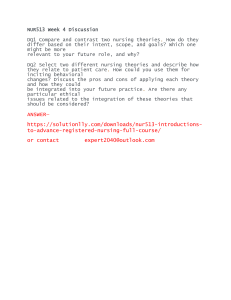
HEALTH EDUCATION BY JOBERT RAMOS Week 13: The Learning Process Learning is change behavior from exposure. Learning occurs from the point of view as the end result of outcome of teaching Learning happens during the course of learning than the end result of the learning. Learning is a function. Behaviorism (Learner is passive) learns via external processes. Cognitivism (Learning goes beyond external) is an internal process. Constructivism (Learner build on personal experience). Connectivism is self-directed learning. Humanist theory is an outlook that focuses on human beings rather than the supernatural. It solves the problems of Who, Where, What, Why, When, and How. Stages of Learning by Dreyfus (Dreyfus Model): Expert see what needs to be achieved and how to achieve it. Proficient use intuition in decision making. Competent develop after experience. Advance beginner apply what they learn in the novice stage. Novice learn basic terms. Elements of Learning Process: Setting goals. Goals. The teacher must set goals that motivates the student to learn. Selecting appropriate stimuli. Stimuli increases the ability of students to recognize the patient’s specific need in relation to the overall problems of the patient. Perceiving/responding to stimuli Perception making students capable to appraise nursing situation using senses: observation physical condition of patient; reading patient chart and notes; and talking with patient and doctor involving care. Response is the ability of student to identify patient care needs and formulate an appropriate nursing care plan. Determining consequences Consequences are outcome of nursing care rendered by the student to the patient, the expected effects, the side effects or adverse reaction to nursing interventions. Integrating learning process Integration is when the student utilizes personal knowledge and experience to solve current problems. Week 14: Theories and Principles of Learning Basic Principles of Learning 1. Satisfying stimulus – the behavior is reinforced, developed and internalized. Reward is more effective than punishment in changing behavior according to Hoover. 2. Reinforcement – praise, reward, or recognition are major conditions to successful behavioral change. 3. Overlearning – increase memory and improves learning performances. 4. Cognitive – readiness to change based on desire. 5. Ordering of information – influences ease of learning. 6. Stimulus response association and discrimination – prerequisite to change behavior. 7. Cognitive construct – perceptual imagery and recognition. 8. Multiple discrimination and generalizing – responses, observes, and analyzes events. 9. Previous knowledge – recall previous knowledge learned. 10. Critical thinking skills – through observing and imitating action. 11. Flexibility – ability to change or adapt. 12. Feedback – about topics and performances. 13. Balanced growth and development patterns Five Process of Learning 1. Learning is a treasure. To broaden knowledge, skills and attitude. 2. Learning to know. More on mastery of learning tools. 3. Learning to do. Acquisition of competence to improve. 4. Learning to live in peace and harmony. To practice together solve problems. 5. Learning to be. To complete fulfillment of men. Learning According to Heidgerken (1981) Learning is unitary and holistic. Inward life, psycho-spiritual reality of mind and spirit. Outward life, bio-physical reality of body and senses. Learning is individual and social. Independent Learning Cycle: o Question o Plan o Find and evaluate o Organize key example o Synthesize o Reflect o Communicate o Evaluate Learning is self-active and self-initiating. Learning is purposive and goal-oriented. Learning is selective and creative. Learning is influential and is transferrable. Conditions of Learning Verbal information. Expresses ideas, or actions. Intellectual skills. Learning to synthesize; and plan. Cognitive strategies. Recognition of experiences; Resources are used. Motor skills. Action done. Attitudes, feelings and emotions. facilitated by learning. thoughts Laws of Learning 1. Law of readiness – must be ready to learn 2. Law of exercise – repetition of outcome 3. Law of effect – emotional responses 4. Law of primacy – create a strong impression 5. Law of intensity – core learning occurs 6. Law of recency – recently learned are best to remember Learning Theories Stimulus response theory Cognitive theories in learning Bandura’s social learning theory Stimulus response theory Classical conditioning Connectionism theory Operant conditioning Behaviorism theory Contiguity theory analyze; learning Evoked Major Types of Learning 1. Ideational learning – pursued in cognitive domain a. cognition – knowledge thru perception b. perception – begins with sensation c. concept – an idea or mental image d. principles – generalization that implies action 2. Skills or psychological learning – implies learned responses to situations 3. Emotional learning – refers to mental state characterized by feelings and emotions. a. emotion and will – accept and cope with rejection b. attitudes – disposition, readiness, inclination c. values in emotional learning – values learned thru observation d. appreciations – develops as a result of emotional experiences Different Learning Styles 1. Diverging – look from different perspectives 2. Assimilating – concise and logical in their approach 3. Converging – use learning to find solutions 4. Accommodations – hands on Cognitive theories Insight theory – Kohler Field theory – Kurt Lewin Discovery theory – Jerome Brunner Schema theory – Rumelhart Assimilation theory – David P. Ausubel Social learning theory states that people learn from one another via observations, imitation and modeling. Bandura’s proposal on condition necessary for effective modelling: attention – focus or concentration; retention – amount of information remembered; reproduction – replication of image; and motivation – determination. Functionalism Interactionism Significant symbolism Week 16: Communication in Teaching and Learning Elements of Communication Source – who sends the message Message – the information Channel/Transmitter – how you send message Receiver – accepts message Noise – interferes the communication. Feedback – is use to ensure the message’s meaning is close. Effective Communication Listening to others Maintaining eye contact with speakers Seeking opinion from others Accepting ideas from others Factors Influencing Effective Communication Communication skills Knowledge Attitude Social status Types of Communication 1. Verbal communication – through speaking or sign language. 2. Nonverbal communication – body language, gesture, facial expressions 3. Visual communication – photographs, art, drawing, sketch, chart, and graphs 4. Written communication – writing, typing, and printing Ten Effective Communication Skills for Nurses 1. Trust 2. Personal Connection 3. Cultural Awareness 4. Compassion 5. Patient Education 6. Presentation Skills 7. Nonverbal Communication 8. Written Communication 9. Active Listening 10. Verbal Communication Week 17: Program Evaluating the Teaching Evaluation According to Gregorio. Process of judging the value of something through careful appraisal Assists in establishing specific goals and objectives Process of helping the individual or group to be self-directing Serves as the criteria for judging desirable changes. Evaluation in Nursing According O’Connor Requires assessment of the cognitive outcomes and knowledge and understanding a delineation of what is and what shall be. Requires evaluation of student’s personal traits, since nursing is personal services, one in which interpersonal are important. Uses skills for appraisal purposes to determine one’s strengths and weaknesses, how a nurse performs efficiently and effectively to meet desired goals and objectives of care Evaluation According Levine and Feldman Measurement of appraisal of an activity in terms of a particular standard. Continuous process of gathering data, and recording, assembling and interpreting information for the purposes of creating change that will promote better performance or accomplish desired objectives. Evaluation Based on Principles According to De Young 1st Principle – anything that exists at all exists in some amount and therefore can be measured. 2nd Principle – the worth or value of a teaching method, a learning method and materials of instruction is not known until their effect is measured. Function of Educational Evaluation Improve the educational program Achieve educational goals Motivate and guide learning process Motivate the teacher to evaluate critically her teaching practices Motivate the faculty to work together for the improvement of the curriculum Purposes of Evaluation Determine level of knowledge Assess level of the student’s clinical performance Become aware of the specific difficulties of individual students Diagnose every student’s strengths and weaknesses Encourage student’s learning Help student acquire the attitude and skills in selfevaluation Help students become increasingly self-directing in their pursuit of knowledge Provide more examinations and opportunities Estimate the effectiveness of teaching and learning techniques Gather information needed for administrative purposes Steps in Evaluation State objectives Define change of behavior expected List and briefly describe situations that give opportunity for the expression of the behavior desired Develop appropriate and systemic means of eliciting kinds of behavior Decide ways of recording and summarizing Check validity, reliability, and difficulty of the measures used Establish condition that permits the student to give their best performance Assign scores on the basis of the foregoing steps Develop methods of interpretation Criteria for Selection of Evaluative Devices Sampling of the objectives Sampling of the content Validity Reliability Practicality Usefulness Widely Used Evaluative Devices Essay examinations Objective examinations Objective problem-solving situations Standardized tests Rating scales Evaluating the Teacher Tape and video recording Observation by a colleague Student opinion Teacher self-evaluation


